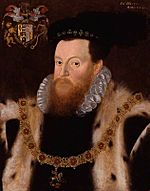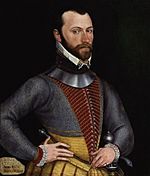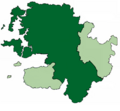Tibbot na Long Bourke, 1st Viscount Mayo facts for kids
Quick facts for kids Tibbot na Long BourkeTeabóid na Long de Búrca |
|
|---|---|
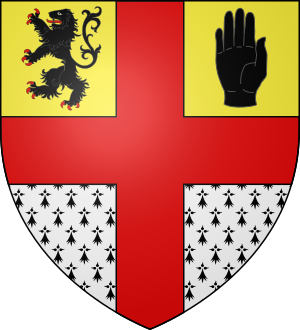
Arms of Bourke, Viscount Mayo
|
|
| 1st Viscount Mayo | |
| Reign | June 1627 - June 1629 |
| Predecessor | Title Created |
| Successor | Miles Bourke, 2nd Viscount Mayo |
| Born | c. 1567 At sea |
| Died | 18 June 1629 (aged 61-62) County Mayo, Ireland |
| Burial | Ballintubber Abbey, County Mayo |
| Consort | Maeve O'Conor |
| Issue | 8 |
| House | Mac William Íochtar |
| Father | Risdeárd an Iarainn Bourke (d. 1583) |
| Mother | Grace O'Malley (d. 1603) |
| Religion | Catholic |
|
Sir
Tibbot ne Long Bourke
|
|
|---|---|
| Member of Parliament for County Mayo |
|
| In office 18 May 1613 – 24 October 1615 |
|
| Monarch | James I |
| Preceded by | New office |
| Succeeded by | Thomas Burke |
Tibbot na Long Bourke, 1st Viscount Mayo (also known as Theobald Bourke) was an important Irish nobleman and politician. He was born in 1567 and died on June 18, 1629. Tibbot was a leading member of the Mac William Íochtar family from County Mayo. He served as a Member of Parliament in the Irish House of Commons. Later, he became the first Viscount Mayo.
Tibbot's life shows how difficult it was for Irish noble families to change from their old Gaelic ways. This happened during the time when England, under the Tudor monarchs, was taking more control of Ireland.
His name, "Tibbot," comes from the French name "Thibault," which means Theobald. "Na Long" means "of the ships" in Irish. This is because he was born on a ship! In his time, people often called him Tibbot na Long.
Contents
The MacWilliam Families
Tibbot's family history goes back to William de Burgh. He was given control of the area of Connacht in 1215 by King John Lackland of England. William's son, Richard, took control of much of Connacht in the 1200s.
Over time, the family's lands split into two main groups:
- Mac William Uachtar (Upper), based in County Galway.
- Mac William Íochtar (Lower), based in County Mayo.
These families held onto their lands for centuries. They often fought against both Irish and Norman enemies. They were known as Hiberno-Norman families. This means they were originally Norman but had married into local Irish families. By the 1400s, they had adopted many Irish customs and the Gaelic culture.
Tibbot's Early Life
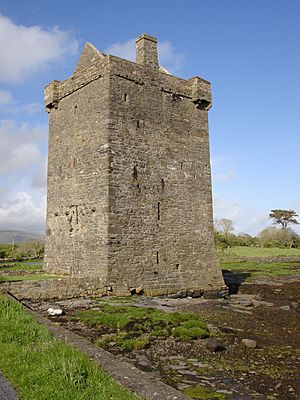
Tibbot's mother was the famous pirate queen, Grace O'Malley (1530–1603). His father was Richard "the Iron" Bourke. Richard was the leader of the Lower MacWilliam Burke clan. Both of Tibbot's parents owned land along the west coast of County Mayo.
As mentioned, Tibbot was born at sea. It is said that he was born just before his mother's ships fought a battle with Barbary pirates.
In 1585, Tibbot married Maeve, who was the daughter of Donal O'Conor Sligo. They had eight children together.
Changes in Leadership (1576–1592)
From 1541, the new Kingdom of Ireland was created by King Henry VIII. The English government wanted to include the self-governing Irish chiefs. They tried to do this through a process called "surrender and regrant." This meant chiefs would give up their lands to the King. Then, the King would grant them back under English law.
After a rebellion in 1569–76, the English government in Dublin decided to apply this process in Connacht. This included the Lower MacWilliam Bourke clan. At this time, the clan owned most of the western part of County Mayo.
In 1576, Tibbot's mother, Grace, made an agreement with Sir Henry Sidney. He was the Lord Deputy, the King's representative. She did this for her own lands.
However, within the Lower MacWilliam Burke clan, Tibbot's father, Richard, was the "tanist." A tanist was chosen by the clan as the next leader. If the clan adopted the English "surrender and regrant" system, Richard would lose his chance to be chief. Instead, the current chief's son would inherit under English law. So, Richard sided with the Earl of Desmond, who was against Sidney. Meanwhile, Grace used her ships to raid Desmond's lands in 1577. She was captured by him until 1579.
In 1580, Richard made a good peace deal with Grey, the next Lord Deputy. Richard was recognized as a clan chief by the English Crown. This was special because he didn't have to use the "surrender and regrant" system.
By 1585, Grace and Tibbot, who was 19, were leading the Lower MacWilliam Burke lands. That year, the new Lord Deputy, Sir John Perrott, wanted to secure the province. He took Tibbot as a hostage to make sure Grace followed the new rules. While he was a prisoner, Tibbot learned English. He also married Maeve, the daughter of Donal O'Conor Sligo.
In 1586, the Lower MacWilliam clan was still divided over who should be the next leader. Tibbot was freed by Richard Bingham to help Perrott's plans. But Tibbot joined a rebellion instead. By 1587, he sought a truce. He rebelled again in 1589 and finally made peace in March 1590. By this time, he was recognized as the clan chief. He agreed to the terms and paid his rent to the Crown.
However, when Red Hugh O'Donnell escaped from Dublin Castle in 1592, Tibbot gathered support in Mayo for him. His attacks on Bingham's forces failed. No help arrived from Spain, and O'Donnell asked for peace. Tibbot was left without support but was given another pardon.
The Nine Years' War
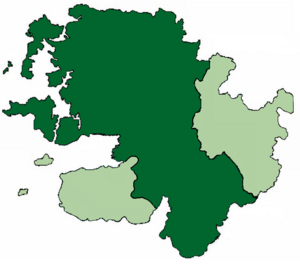
Before the Nine Years' War began in 1593, there was fighting between the English government and Irish leaders like Hugh Roe O'Donnell. Tibbot wrote to another leader, saying he would raise an army in Mayo to help them. This led to Tibbot's arrest in May 1593. He was held at Athlone.
His mother, Grace, visited Queen Elizabeth in London in June 1593. She managed to get Tibbot released. Tibbot agreed to fight some of his Burke cousins who were rebelling. His son Miles was held as a hostage by Bingham.
In April 1594, Grace visited Queen Elizabeth again. She finally got good terms for Tibbot to keep his lands under English law. This visit was very important for Tibbot. The Nine Years' War was starting. In 1595, O'Donnell tried to replace Tibbot as clan chief with another cousin, Tibbot Kittagh. But Tibbot soon got his position back in Mayo.
Because of this, Tibbot did not join O'Donnell and his main ally Hugh O'Neill in the war. He first helped the English government. Later, he took a less active role. The English leader, Clifford, was defeated in 1599. While the rebels marched south, Tibbot sailed south with 300 men on three ships. He kept both sides guessing about who he would help.
Life in the 1600s
In 1603, James I became King after Elizabeth. O'Neill surrendered to the terms of the Treaty of Mellifont. The next year, Tibbot was knighted and called "Sir Tibbot ne Longe Bourke." For the first time, all of Ireland was under English control.
After the Flight of the Earls in 1607, Tibbot was accused of planning to help them escape. He was arrested in 1608, but it turned out to be false. In 1610, he was again suspected. The government found letters from Spain that seemed to involve him in a revolt. But again, he was pardoned.
Tibbot also helped smaller local clans with their land dealings with the English government. By the time he died, he seemed to have gained most of their lands. His own tenants paid him rent with crops. This was called "cuttings and spendings." They would give him about a quarter or a third of their harvest. This method worked well in Ireland's wet climate. In 1633, his son Miles received an annual rent from one area. It included money, a beef animal, butter, and basins of meal and malt.
Political Role (1613–1629)
From 1613 to 1615, Tibbot was one of two Members of Parliament (MPs) from Mayo in the Parliament of Ireland. He was still Catholic. He voted against creating new areas for Protestant MPs. The new rules gave Protestants more seats in Parliament.
The Anglo-Spanish War (1625–30) started soon after Charles I became King. Tibbot and his son Miles were again accused of planning a Catholic revolt with Spanish help. They were cleared of these charges.
Soon after, in June 1627, Tibbot was made the 1st Viscount Mayo. His first name was now officially Theobald. In 1628, he and other Catholic nobles started a petition. They wanted King Charles to change some anti-Catholic laws. These changes were known as "The Graces." Tibbot died on June 18, 1629, and was buried at Ballintubber Abbey.
Even though Tibbot remained Catholic, he made sure his son Miles became Anglican (Protestant) for political reasons. Miles was educated at Oxford University. Tibbot's other children remained Catholic.
Family Life
Tibbot married Maeve (also called Maud) in 1585. She was the daughter of Charles O'Conor Sligo. Maeve died in 1636. They had several daughters and four sons:
- Miles, who became the 2nd Viscount. He died in 1649.
- David, who died in 1677 without children.
- Theobald Riabach, who died in Spain in 1654.
- Richard.
Miles's family line continued until the 8th Viscount died in 1767.
An Tighearna Mhaigheo (Lord Mayo)
David Murphy, a musician from County Mayo, is one of two people credited with writing the tune An Tighearna Mhaigheo (Lord Mayo).
The story goes that David Murphy, a very talented man, was helped by Lord Mayo (Tibbot na Long Bourke). But Murphy did something wrong and made Lord Mayo angry. Murphy wanted to make up with him. A friend suggested that a song praising Lord Mayo and showing Murphy's regret would be the best way.
The result was a beautiful song. Murphy hid in Lord Mayo's hall on Christmas Eve. At the right moment, he sang the song, asking for forgiveness. The song was very emotional and heartfelt.
Here are two lines from the song:
- Mayo whose valor sweeps the field
- And swells the trump of Fame;
Family Coat of Arms
Images for kids
-
Rockfleet Castle, a main home of Tibbot's father.
-
Extent of the Mac William Iochtar Territory within County Mayo, around 1590.
More to Explore
- Earl of Mayo
- Clanricarde


